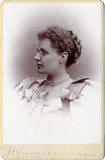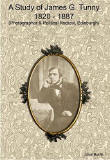investigatesthe photographic contents of two bottles |
|
Photography and Chemistry In the 19th century, photographers' skills extended well beyond reading instruction labels for equipment and chemicals. Even as late as the 1880s, an understanding of chemistry and a willingness to experiment with the chemistry were a part of photography, as can be seen from JG Tunny's comments below. |
|
EPS Meeting 1882 On 1 March 1882, the Edinburgh Photographic Society Meeting was described as being unusually large, and terminating at a late hour. The final event of the Meeting was a report from James Good Tunny who had been given two bottles and asked to investigate their photographic ingredients. [BJP: 1881, p.142] JG Tunny said: "These solutions are sent out, I understand for strengthening or giving density to negatives. No 1 is an old friend (or rather, I should say, an old enemy) under a new name. It is a mercuric iodide in an excess of potassic iodide. I shall put a little of the solution into this test tube. I add a few drops of bichloride of mercury, and now you see the bright scarlet colour of iodide of mercury. In the other test tube I shall put a little of the No 1 solution, and now add a few drops of nitrate of silver; there you see the yellow precipitate of iodide of silver. This then is the active principle of the bottle No 1. No.2 bottle contains cyanide of silver. In order to prove so, I shall place in this tube a small quantity of it. A drop or two of muriatic acid added instantly forms a curdy precipitate of chloride of silver. In the other tube I shall add to the No 2 solution a few drops of nitrate of silver. This you will see instantly forms a heavy precipitate of cyanurate of silver. This is exactly the solution that Monckhoven, more than two years ago, gave to the public for the intensifying of negatives. Those who wish to make these solutions for themselves will find the following formulae answer admirably: No1 - bichloride of mercury: 20 grains - iodide of potassium: 60 grains - grind up these in a mortar with a few drops of water No2 - 30 grains of nitrate of silver dissolved in 2 ounces of water - 60 grains of cyanide of potassium dissolved in 2 ounces of water - when dissolved, add the two together - filter into a 20 ounce bottle and fill up with water. But for my own working I prefer bromide of potassium instead of the iodide that is used in No 1 solution using 30 grains of bromide instead of 60 grains of iodide. In conclusion: the note of warning cannot be too often sounded. Beware of using mercury in any form for the strengthening of negatives; many valuable ones have been lost by it. It is a powerful and valuable agent. Recently I have subjected all intensified negatives by it to a bath of saturated sulphate of iron. So far as these have been tested there seems to have been little change after an exposure of some weeks to the little sun that has been available recently. |
|
James Good Tunny 1820-1887 |
||
|
EPS |
Photos |
|
|
Family |
Edinburgh Views |
|
|
Businesses |
||
|
Cartes de Visite |
Cabinet Prints |
|
|
Book Here is a link to a web page that gives details of a book, written and published in 2009 by Julian Bukits, on the life and work of James G Tunny |
||


